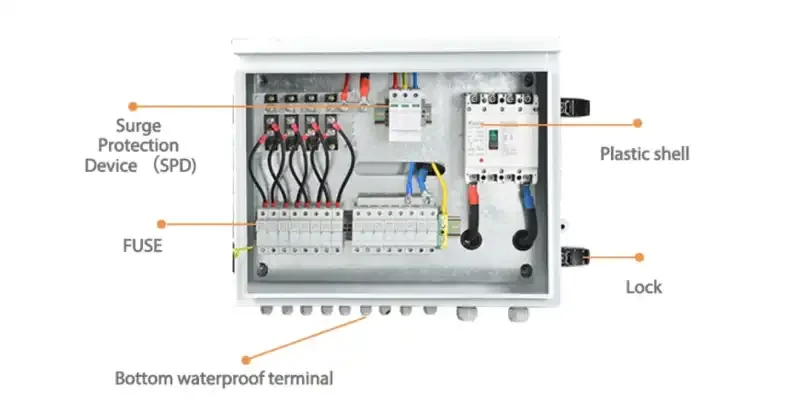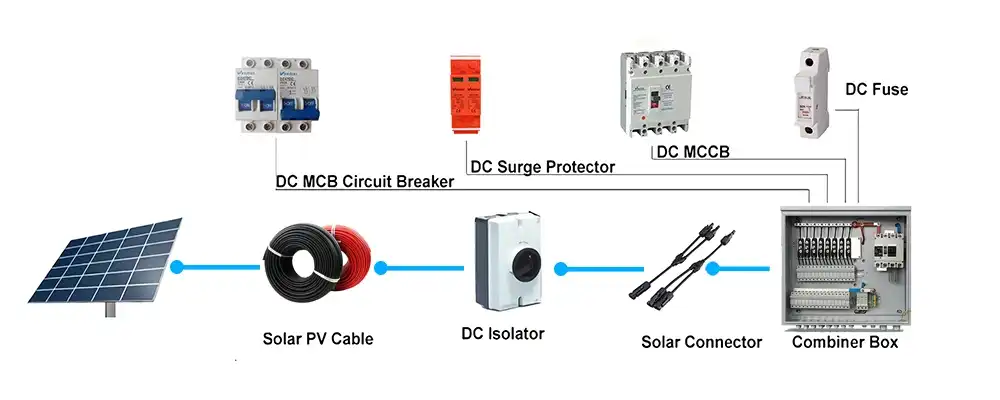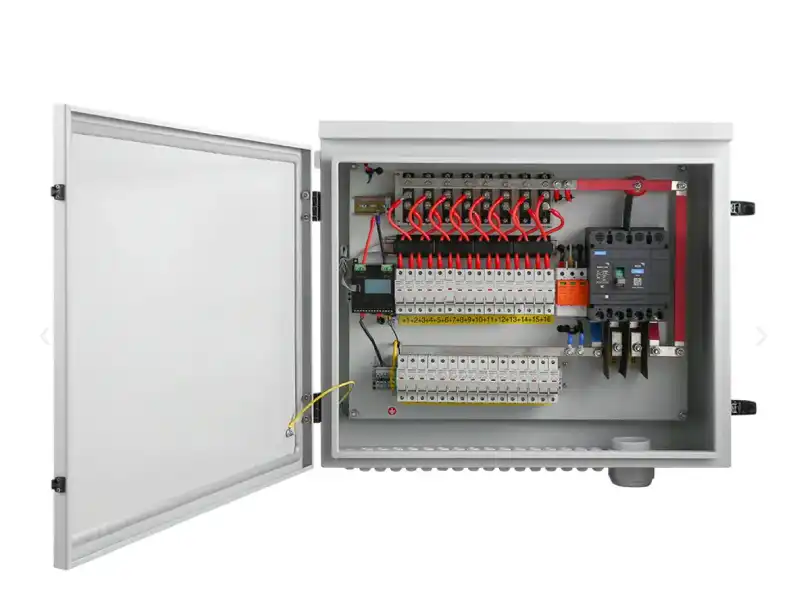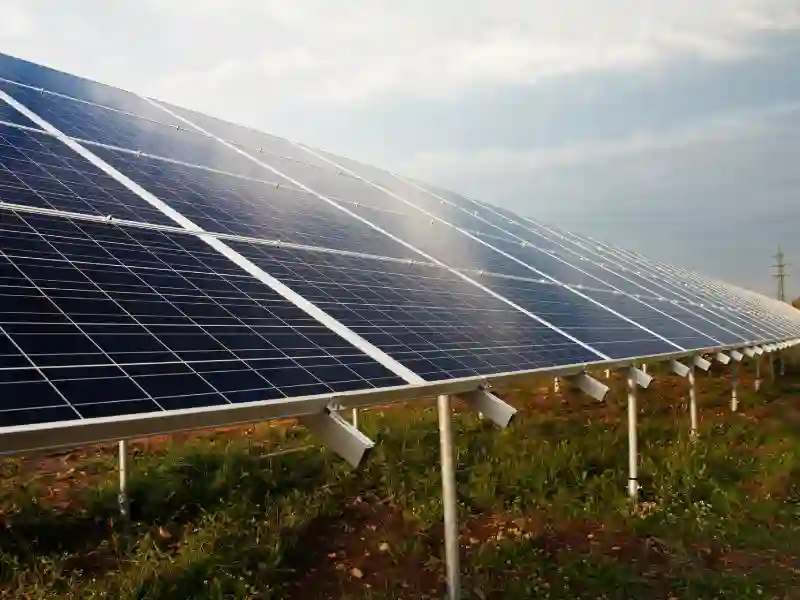I. Вступ
A. Визначення фотоелектричного сонячного комбінованого блоку
Сонячний комбінований блок - це важливий компонент в системах сонячної енергетики, призначений для об'єднання виходів декількох ланцюжків сонячних панелей в один вихід, який підключається до інвертора. Цей пристрій відіграє важливу роль як в домашніх, так і в комерційних сонячних установках, особливо при управлінні великою кількістю сонячних панелей.
B. Важливість у сонячних енергетичних системах
Ефективність: Впорядковуючи з'єднання і мінімізуючи кількість проводів, комбіновані коробки сприяють більш ефективному розподілу енергії в сонячних електростанціях. Ця ефективність особливо важлива у великих установках з декількома рядами панелей, де управління численними з'єднаннями може стати складним завданням.
Економічна ефективність: Зменшення складності електропроводки не тільки економить на матеріальних витратах, але й знижує витрати на робочу силу при монтажі. Для великомасштабних сонячних проектів це може призвести до значної економії в цілому.
Підвищена надійність: Завдяки вбудованим захисним функціям розподільні коробки забезпечують безпечну та надійну роботу інвертора. Вони захищають від електричних несправностей, які можуть призвести до виходу системи з ладу або загрози безпеці.
Адаптивність: У той час як невеликі побутові системи можуть не потребувати комбінованої коробки, якщо вони мають від однієї до трьох струн, великі системи - від чотирьох струн до тисяч - значно виграють від їх використання. Така адаптивність робить комбіновані коробки придатними як для житлових, так і для комерційних застосувань.
II. Основи фотоелектричних сонячних комбінованих блоків
A. Функція та призначення
Поєднання результатів: Основна функція сонячного розподільчого пристрою - об'єднати вихід постійного струму (DC) з декількох сонячних панелей в один вихід. Це спрощує підключення до інвертора, який перетворює постійний струм в змінний для використання в будинках і на підприємствах.
Мінімізація складності електропроводки: Об'єднуючи виходи з декількох ліній, комбіновані коробки зменшують кількість окремих проводів, які потрібно прокласти до інвертора. Це не тільки спрощує монтаж, але й мінімізує потенційні точки відмови та зменшує трудовитрати, пов'язані з прокладанням проводки.
Захист від перенапруги: Комбіновані коробки оснащені захисними пристроями, такими як запобіжники або автоматичні вимикачі для кожної вхідної лінії. Ці компоненти мають вирішальне значення для запобігання ситуацій перевантаження по струму, які можуть пошкодити сонячні панелі або інші електричні компоненти системи.
Можливості моніторингу: Багато комбінованих блоків мають функції моніторингу, які дозволяють відстежувати продуктивність окремих сонячних модулів. Ця функція допомагає діагностувати проблеми та забезпечувати оптимальну продуктивність системи.
Функції безпеки: Вони часто включають в себе роз'єднувачі та пристрої захисту від перенапруги, які підвищують безпеку, дозволяючи обслуговуючому персоналу ізолювати фотоелектричний масив від решти системи, коли це необхідно.
B. Ключові компоненти
Сонячні розподільчі коробки є невід'ємною частиною сонячних електростанцій і слугують для об'єднання вихідних сигналів від декількох сонячних панелей в один вихід для інвертора. Ефективність і безпека цих систем значною мірою залежать від різних компонентів, розміщених в комбінованій коробці. Ось ключові компоненти, які зазвичай містяться в комбінованих сонячних панелях:
Вимикачі постійного струму
- Функція: Захищає ланцюги від електричних несправностей, перериваючи потік струму в разі ситуацій перевантаження по струму.
- Деталі: Кількість і номінальна потужність автоматичних вимикачів залежать від розміру і конфігурації сонячної системи, забезпечуючи індивідуальний захист кожної лінії.
- Функція: Забезпечує захист колони шляхом продувки під час несправностей, що відключає пошкоджений ланцюг і запобігає пошкодженню інших компонентів.
- Деталі: Тип і номінал запобіжників вибираються на основі специфікацій сонячних панелей і струн.
Пристрої захисту від перенапруги (SPD)
- Функція: Захищає систему від стрибків напруги, спричинених блискавкою або іншими електричними перенапругами.
- Деталі: SPD відводять надлишкову напругу на землю, захищаючи чутливе обладнання, наприклад, інвертори, від пошкоджень.
- Функція: Дозволяє безпечно відключати живлення від сонячної батареї для технічного обслуговування або в аварійних ситуаціях.
- Деталі: Цей вимикач може ізолювати певні частини системи, забезпечуючи безпеку під час обслуговування.
- Функція: Виконує роль механічного провідника, який об'єднує кілька виходів ланцюга в один.
- Деталі: Зазвичай знаходиться всередині коробки, де сходяться всі вхідні дроти перед тим, як потрапити до інвертора.
Додаткові компоненти
- Блокувальні діоди: Запобігають зворотному перетіканню струму з однієї струни на іншу, що допомагає підтримувати оптимальну продуктивність.
- Обладнання для моніторингу: Просунуті комбіновані блоки можуть включати пристрої для моніторингу показників продуктивності, які допомагають швидко виявляти проблеми.
- Матеріал корпусу: Сама коробка часто виготовляється з міцних матеріалів, таких як нержавіюча сталь або стійкий до ультрафіолетового випромінювання пластик, що забезпечує захист від факторів навколишнього середовища.
C. Типи комбінованих коробок
Сонячні розподільні коробки є важливими компонентами сонячних фотоелектричних систем (ФЕС), призначеними для об'єднання вихідних сигналів декількох сонячних панелей в один вихід для підключення до інвертора. Існують різні типи розподільчих коробок, призначених для задоволення конкретних потреб і конфігурацій сонячних установок. Ось основні типи:
Стандартна комбінована коробка постійного струму
Функція: Об'єднує виходи постійного струму з декількох сонячних батарей перед тим, як вони потрапляють до інвертора.
Особливості: Зазвичай включає пристрої захисту від надмірного струму, такі як запобіжники або автоматичні вимикачі для кожної струни, щоб забезпечити безпеку і запобігти пошкодженню в разі несправностей.
Комбінований блок моніторингу на рівні рядків
Функція: Об'єднує виходи, одночасно контролюючи продуктивність кожної струни окремо.
Можливості: Дозволяє здійснювати моніторинг у реальному часі, допомагаючи виявляти такі проблеми, як затінення або несправності в певних панелях, покращуючи управління системою.
Розумна комбінована коробка
Функція: Просунута версія, яка об'єднує виходи, контролює продуктивність і взаємодіє з іншими компонентами системи.
Особливості: Інтегрується з системами енергоменеджменту та інверторами для оптимізації продуктивності та ефективності.
Комбінований блок змінного струму
Функція: Використовується в установках з мікроінверторами або модулями змінного струму для консолідації виходу з декількох інверторів.
Особливості: Полегшує підключення до головного електричного щита, ефективно керуючи розподілом електроенергії змінного струму.
Біполярна комбінована коробка
Призначення: Призначений для систем як з позитивним, так і з негативним заземленням.
Особливості: Працює з обома полярностями постійної напруги, що важливо для певних сонячних установок, які потребують такої конфігурації.
Гібридна комбінована коробка
Функція: Використовується в гібридних системах, які включають в себе як сонячні, так і інші джерела енергії, наприклад, вітрові або генератори.
Особливості: Об'єднує виходи від різних джерел перед підключенням до контролерів заряду або інверторів.
Індивідуальний комбінований ящик
Функція: Розроблено відповідно до унікальних специфікацій конкретних сонячних установок.
Функції: Може включати додаткові функції, такі як захист від перенапруги, блискавковідводи або спеціалізовані компоненти відповідно до вимог проекту.
Пластикові та залізні корпусні комбіновані коробки
Пластиковий корпус: Забезпечує високу ізоляцію, корозійну стійкість і має невелику вагу, що полегшує монтаж і обслуговування.
Залізний корпус: Забезпечує стійкість до високої напруги та довговічність, але є важчим; підходить для більш жорстких умов експлуатації.
III. Конструкція та конфігурація сонячних комбінованих блоків
Конструкція та конфігурація сонячних розподільчих коробок мають вирішальне значення для забезпечення ефективності, безпеки та надійності сонячних електростанцій. Ці коробки слугують центральним вузлом для об'єднання вихідних сигналів декількох рядів сонячних панелей перед їх підключенням до інвертора. Нижче наведені ключові аспекти їхньої конструкції та конфігурації.
Конструкція корпусу
- Матеріали: Комбіновані коробки зазвичай виготовляються з таких матеріалів, як метал (пофарбована сталь або нержавіюча сталь), пластик або склопластик. Вибір матеріалу впливає на довговічність, вагу та стійкість до факторів навколишнього середовища.
- Рейтинги NEMA: Більшість розподільчих коробок призначені для зовнішнього використання і мають рейтинг NEMA (наприклад, NEMA 3R, 4 або 4X), який вказує на їхню здатність протистояти впливу вологи та пилу. Вищий рейтинг NEMA забезпечує кращий захист від суворих погодних умов.
Внутрішні компоненти
- Захист від перенапруги: Кожна розподільна коробка містить запобіжники або автоматичні вимикачі для кожної сонячної батареї для захисту від перенапруги. Це необхідно для запобігання пошкодження сонячних панелей та інвертора.
- З'єднувальні блоки: Ці компоненти полегшують з'єднання декількох вхідних проводів від сонячних батарей до одного вихідного проводу, що веде до інвертора, зменшуючи складність електропроводки.
- Пристрої захисту від перенапруги: Багато розподільчих коробок оснащено пристроями захисту від перенапруги для захисту від стрибків напруги, спричинених блискавкою або іншими електричними перенапругами.
Міркування щодо охолодження
- Розмір і потік повітря: Розмір комбінованого корпусу може впливати на ефективність охолодження. Більші корпуси забезпечують кращий потік повітря, який допомагає розсіювати тепло, що виділяється внутрішніми компонентами. Належна вентиляція має важливе значення для продовження терміну служби компонентів всередині.
- Місце встановлення: Встановлення комбінованого блока в затінених місцях (наприклад, на стіні, що виходить на північ) може зменшити накопичення тепла, підвищити продуктивність і довговічність роботи.
Параметри конфігурації
- Моніторинг на рівні струн: Деякі просунуті комбінатори пропонують можливості моніторингу, які дозволяють користувачам відстежувати продуктивність окремих рядків. Ця функція корисна для виявлення таких проблем, як затінення або несправність панелей.
- Розумні функції: Інтелектуальні комбіновані блоки можуть включати електронні перемикачі, температурні датчики та комунікаційні інтерфейси, які дозволяють здійснювати дистанційний моніторинг і керування.
Відповідність та безпека
- Електротехнічні норми: Щоб забезпечити безпечну установку та експлуатацію, комбінаторні коробки повинні відповідати місцевим електротехнічним нормам і правилам. Це стосується належного маркування, заземлення та прокладки проводів.
- Доступність для технічного обслуговування: Конструкція повинна забезпечувати легкий доступ для технічного персоналу для проведення перевірок або ремонтів, не порушуючи роботу системи.
IV. Критерії відбору
При виборі сонячного комбінованого блоку для вашої фотоелектричної системи необхідно враховувати кілька ключових критеріїв, щоб забезпечити сумісність, ефективність і безпеку. Нижче наведені найважливіші фактори, якими слід керуватися при виборі:
1 、 Сумісність
Компоненти системи: Переконайтеся, що комбінований блок сумісний з вашими сонячними панелями, інвертором та іншими компонентами вашої системи. Це включає перевірку номінальних значень напруги та струму, щоб вони відповідали вашому конкретному налаштуванню.
2、Кількість входів та виходів
String Count: Визначте, скільки у вас сонячних панелей. Виберіть комбіновану коробку, яка може вмістити загальну кількість входів від ваших сонячних батарей і має достатню вихідну потужність для підключення до інвертора.
3, Поточний рейтинг
Максимальний струм: Виберіть комбіновану коробку з номінальним струмом, який може витримати максимальний струм, вироблений вашими сонячними панелями. Зазвичай номінальний струм не перевищує 15 або 20 А на кожну батарею, залежно від характеристик використовуваних панелей.
4 、 Номінальна напруга
Обирайте розподільчий щиток з номінальною напругою, яка відповідає або перевищує максимальну напругу вашої сонячної електростанції. Це має вирішальне значення для забезпечення безпечної експлуатації та запобігання пошкодженню обладнання.
5、Функції безпеки
Механізми захисту: Шукайте розподільні коробки, які оснащені захисними механізмами, такими як пристрої захисту від перенапруги, запобіжники та автоматичні вимикачі. Ці компоненти захищають вашу систему від електричних збоїв і потенційних пошкоджень.
6 、 Можливості моніторингу
Відстеження продуктивності: Якщо для вашої програми важливий моніторинг продуктивності окремих струн, розгляньте можливість моніторингу на рівні струн або інтелектуального комбіка. Ці опції дозволяють відстежувати продуктивність у реальному часі і допомагають швидко виявляти проблеми.
7、Матеріал корпусу
Довговічність: Вибирайте комбайнер, виготовлений з міцних матеріалів, таких як нержавіюча сталь або високоякісний полікарбонат, щоб він міг витримувати суворі погодні умови та вплив навколишнього середовища.
8 、 Розмір та міркування щодо охолодження
Фізичні розміри: Розмір комбінованої коробки повинен відповідати місцю встановлення та забезпечувати достатній потік повітря для охолодження внутрішніх компонентів. Більший корпус може підвищити ефективність охолодження та полегшити обслуговування.
9 、 Вимоги до встановлення
Простота встановлення: Подумайте, чи зможете ви встановити комбіновану коробку самостійно, чи вам знадобиться професійна допомога. Деякі коробки можуть бути оснащені функціями, які спрощують встановлення, тоді як інші можуть вимагати більш складних процедур налаштування.
10、Вартісні міркування
Бюджет: Оцініть вартість комбінаторної коробки у співвідношенні з її функціями та перевагами. Хоча може виникнути спокуса вибрати дешевші варіанти, інвестиції у високоякісні компоненти можуть призвести до кращої довгострокової продуктивності та надійності.
V. Найкращі практики встановлення
Встановлення сонячного розподільчого щита є важливим етапом у налаштуванні сонячної фотоелектричної системи (ФЕС). Правильний монтаж забезпечує ефективність, безпеку та надійність сонячної енергетичної системи. Нижче наведено найкращі практики, яких слід дотримуватися під час процесу встановлення:
1. Підготовка та планування: Ознайомтеся з інструкціями виробника: Завжди звертайтеся до інструкцій виробника щодо конкретних процедур встановлення та рекомендацій з техніки безпеки, пов'язаних з моделлю комбінованої коробки, яку ви використовуєте.
2. Вибір правильної локації
- Близькість до сонячних панелей: Встановіть розподільчу коробку близько до сонячних панелей, щоб мінімізувати падіння напруги та зменшити довжину проводки. Таке розміщення підвищує ефективність, забезпечуючи оптимальну передачу енергії.
- Доступність: Переконайтеся, що місце розташування забезпечує легкий доступ для технічного обслуговування та усунення несправностей. Вдало розміщена комбінована коробка полегшує регулярні перевірки та ремонт.
- Захист навколишнього середовища: Встановіть коробку в затіненому місці, наприклад, на стіні, що виходить на північ, щоб зменшити вплив прямих сонячних променів. Це допоможе запобігти перегріванню внутрішніх компонентів.
3. Монтаж комбінованої коробки
- Надійна установка: Використовуйте відповідне кріпильне обладнання, щоб надійно прикріпити комбіновану коробку до міцної поверхні. Переконайтеся, що вона вирівняна і закріплена належним чином, щоб протистояти вітру та іншим факторам навколишнього середовища.
- Захист від негоди: Вибирайте місце, яке забезпечує додатковий захист від впливу навколишнього середовища, навіть якщо коробка захищена від погодних умов. Це може подовжити термін його служби та підвищити продуктивність.
4. З'єднання фотоелектричних ланцюгів
- Правильне з'єднання проводів: Підключіть кожну фотоелектричну лінію до відповідної клеми в комбінованій коробці, дотримуючись правильної полярності (плюс до плюса і мінус до мінуса). Для надійного з'єднання використовуйте високоякісні роз'єми та дотримуйтесь специфікацій затягування.
- Встановлення захисту від надмірного струму: Встановіть запобіжники або автоматичні вимикачі для захисту від перевантаження по струму для кожної струни. Переконайтеся, що ці пристрої мають відповідний номінал відповідно до специфікацій вашої системи.
5. Управління електропроводкою
- Організована прокладка: Акуратно прокладіть електропроводку від фотоелектричних модулів до розподільчої коробки, мінімізуючи вигини та перешкоди. Використовуйте кабельні хомути або стяжки, щоб закріпити проводку та захистити її від пошкоджень.
- Підключення заземлення: Належним чином заземлюйте провідники заземлення від фотоелектричних модулів та інших компонентів, щоб забезпечити безпеку та відповідність електротехнічним нормам.
6. Тестування та введення в експлуатацію
- Тестування системи: Після встановлення проведіть ретельне тестування напруги, струму та безперервності, щоб переконатися в правильній роботі сонячної фотоелектричної системи. Перед увімкненням перевірте всі з'єднання на безпеку та функціональність.
- Документація: Задокументуйте всі деталі встановлення, включаючи електричні схеми, специфікації обладнання, результати випробувань і будь-які зміни, зроблені під час встановлення. Ця документація важлива для подальшого використання та обслуговування.
VI. Обслуговування та усунення несправностей
Обслуговування та усунення несправностей сонячних комбінованих блоків має важливе значення для забезпечення ефективності та довговічності сонячної електростанції. Регулярне технічне обслуговування може запобігти виникненню проблем, в той час як усунення несправностей допомагає виявити і вирішити проблеми, коли вони виникають. Нижче наведено найкращі практики як для обслуговування, так і для усунення несправностей.
Найкращі практики технічного обслуговування
Регулярні перевірки
- Візуальні перевірки: Періодично оглядайте коробку комбайна на наявність ознак зносу, корозії або пошкоджень. Шукайте ослаблені з'єднання, обірвані дроти або будь-які ознаки перегріву.
- Чистота: Тримайте внутрішню частину комбайна в чистоті. Пил і сміття можуть накопичуватися, потенційно впливаючи на продуктивність. Використовуйте м'яку тканину для протирання поверхонь і переконайтеся, що жодні сторонні предмети не заважають електричним компонентам.
Перевірка з'єднань
- Герметичність: Переконайтеся, що всі дротяні з'єднання надійно закріплені. Нещільні з'єднання можуть призвести до падіння напруги та неефективності.
- Окислення: Перевірте роз'єми на наявність ознак окислення або корозії, які можуть перешкоджати проходженню електричного струму. За потреби очистіть або замініть корозійні роз'єми.
Обслуговування запобіжників і автоматичних вимикачів
- Заміна запобіжника: Якщо запобіжник перегорів, його необхідно замінити на новий такого ж номіналу. Завжди відключайте автоматичний вимикач перед заміною запобіжників для забезпечення безпеки.
- Випробування автоматичних вимикачів: Регулярно тестуйте автоматичні вимикачі, щоб переконатися, що вони працюють належним чином. Перезавантажте всі вимикачі, що спрацювали, після усунення основної проблеми.
Перевірка захисту від перенапруги
- Стан пристрою захисту від перенапруги: Перевірте пристрої захисту від перенапруги, щоб переконатися, що вони працюють. Багато пристроїв захисту від перенапруги мають візуальні індикатори (наприклад, зелене/червоне світло), які показують їхній стан; замініть їх, якщо вони вказують на несправність.
Екологічні міркування
- Вологість і температура: Слідкуйте за умовами навколишнього середовища навколо комбінованого блока, оскільки надмірна вологість або коливання температури можуть вплинути на його роботу. Переконайтеся, що місце встановлення відповідає використовуваному обладнанню.
Кроки з усунення несправностей
Початкова оцінка
- Перевірка продуктивності системи: Почніть з перевірки загальної продуктивності сонячної системи на інверторі або вимірювальній системі. Зафіксуйте рівні вхідної напруги та струму, щоб виявити будь-які відхилення від очікуваних значень.
- Виявлення симптомів: Визначте, чи вся система в цілому або окремі рядки не працюють належним чином або не функціонують.
Перевірте проводку та з'єднання
- Візуальний огляд: Шукайте обірвані дроти, ослаблені з'єднання або пошкоджену ізоляцію всередині та навколо комбінованої коробки.
- Вимірювання сили струму: Використовуйте струмовимірювальні кліщі для вимірювання струму на окремих струнах, щоб виявити будь-які аномалії, які можуть вказувати на несправність панелі або з'єднання.
Перевірка запобіжників і автоматичних вимикачів
- Перевірка запобіжників: Перевірте кожен запобіжник у розподільній коробці на цілісність за допомогою мультиметра; негайно замініть усі перегорілі запобіжники.
- Функціональність вимикачів: Переконайтеся, що автоматичні вимикачі не спрацювали через перевантаження; за потреби перезавантажте їх після усунення основних проблем.
Оцініть захист від перенапруги
Функціональність пристроїв захисту від перенапруги: Перевірте справність пристроїв захисту від перенапруги; замініть ті з них, які не змогли захистити від стрибків напруги.
Професійна допомога
Якщо після виконання цих перевірок проблеми не зникли, проконсультуйтеся з професійним техніком, який спеціалізується на сонячних системах, для подальшої діагностики та ремонту.
VII. Передові функції та технології
Вдосконалені сонячні комбіновані блоки інтегрують передові технології для підвищення продуктивності, безпеки та надійності системи. Ці інновації включають в себе моніторинг в режимі реального часу з можливістю реєстрації даних, інтеграцію інтелектуальних технологій з електронними перемикачами і датчиками температури, а також вдосконалені механізми захисту, такі як вдосконалений захист від перенапруги і захист від переполюсовки. Крім того, сучасні комбіновані блоки часто включають в себе функції оптимізації енергоспоживання, сумісність з гібридними джерелами змінного/постійного струму і конфігурації, що налаштовуються, для задоволення різноманітних вимог проєкту. Покращене терморегулювання, виявлення дугових замикань і функція швидкого вимкнення забезпечують відповідність новим нормам і стандартам безпеки. Ці досягнення в сукупності сприяють оптимізації виходу енергії, спрощенню технічного обслуговування та підвищенню загальної ефективності системи в сонячних електростанціях різного масштабу.
VIII. Дотримання нормативних вимог
A. Вимоги NEC
- Швидке вимкнення (NEC 690.12): Ця вимога передбачає, що фотоелектричні (ФЕ) системи, встановлені на будівлях або всередині них, повинні мати систему швидкого вимкнення. Ця система дозволяє службам швидкого реагування безпечно контролювати всі фотоелектричні ланцюги, обмежуючи напругу між будь-якими провідниками (включаючи заземлення) до 30 В і 240 ВА протягом 10 секунд під час аварійної ситуації. Комбіновані коробки повинні мати засоби відключення, такі як контактори, для знеструмлення ланцюгів біля масиву та інвертора, коли ініціюється швидке вимкнення.
- Захист від дугових замикань (AFCI) (NEC 690.11): Для фотоелектричних систем з джерелом або вихідними ланцюгами постійного струму, що працюють при напрузі 80 В або вище, необхідний захист від дугового замикання. Цей захист повинен бути інтегрований в комбінований блок для виявлення дуги поблизу її джерела, що допомагає мінімізувати час, необхідний для виявлення та усунення несправностей, а також зменшити кількість помилкових спрацьовувань від внутрішніх джерел.
- Локальне відключення (NEC 690.15): У цьому документі зазначено, що вихід постійного струму з комбайнів, встановлених на дахах, повинен бути обладнаний пристроєм відключення навантаження, розташованим всередині комбайна або на відстані не більше 6 футів від нього. Вимикач повинен мати ручне керування, щоб монтажники могли легко отримати до нього доступ для технічного обслуговування або в аварійних ситуаціях.
B. Списки UL
Важливо обирати комбіновані блоки, які сертифіковані третьою стороною на відповідність стандартам UL1741, що регулюють безпеку та продуктивність обладнання, яке використовується в сонячних електростанціях. Ця сертифікація свідчить про те, що розподільний пристрій пройшов перевірку на безпеку і надійність, що знижує ризик виникнення таких небезпек, як пожежа або пошкодження обладнання.
IX. Тематичні дослідження сонячних комбінованих блоків
Сонячні комбіновані блоки відіграють життєво важливу роль у різних проектах сонячної енергетики, полегшуючи інтеграцію та управління декількома лініями сонячних панелей. Нижче наведені деякі приклади, які висвітлюють їх застосування в різних масштабах сонячних установок.
Комунальні сонячні проекти
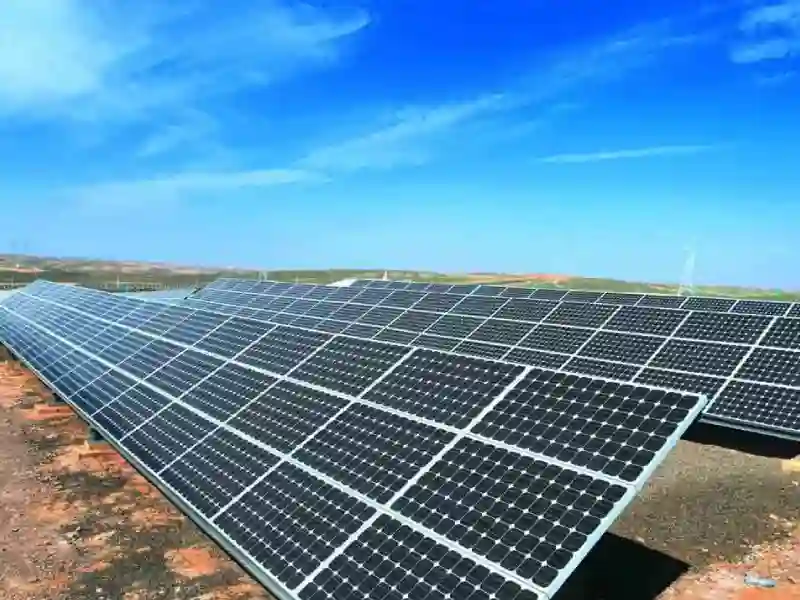 У сонячних електростанціях промислового масштабу розподільні коробки необхідні для управління великими масивами сонячних панелей, які часто складаються з тисяч стрінгів. Наприклад, на великих сонячних фермах комбіновані коробки спрощують процес з'єднання, об'єднуючи вихід з декількох сонячних батарей в один вихід для інвертора. Це не тільки спрощує підключення, але й зменшує трудові та матеріальні витрати, пов'язані з установкою. Оптимізуючи розподіл потужності, ці коробки підвищують загальну ефективність і надійність системи, гарантуючи, що інвертор отримує стабільну і консолідовану вхідну потужність.
У сонячних електростанціях промислового масштабу розподільні коробки необхідні для управління великими масивами сонячних панелей, які часто складаються з тисяч стрінгів. Наприклад, на великих сонячних фермах комбіновані коробки спрощують процес з'єднання, об'єднуючи вихід з декількох сонячних батарей в один вихід для інвертора. Це не тільки спрощує підключення, але й зменшує трудові та матеріальні витрати, пов'язані з установкою. Оптимізуючи розподіл потужності, ці коробки підвищують загальну ефективність і надійність системи, гарантуючи, що інвертор отримує стабільну і консолідовану вхідну потужність.
Побутові сонячні установки
Коробки-розподільники також мають вирішальне значення в житлових приміщеннях, де вони, як правило, керують від однієї до трьох лінійок сонячних панелей. Наприклад, домовласник, який встановлює сонячну систему на даху, може використовувати розподільчу коробку для централізації з'єднань, що полегшує монтаж і обслуговування. Таке налаштування дозволяє домовласникам більш ефективно контролювати виробництво сонячної енергії, мінімізуючи при цьому складність проводки та потенційні точки виходу з ладу. Централізоване розташування розподільчої коробки слугує доступною точкою для технічного обслуговування та усунення несправностей.
Комерційне застосування
У комерційних будівлях розподільні коробки використовуються для консолідації вихідної енергії від декількох сонячних панелей перед підключенням до електричної системи або мережі будівлі. Наприклад, торговий центр з великою сонячною батареєю на даху може використовувати комбіновану коробку для ефективного управління різними лініями. Це не тільки спрощує процес підключення, але й забезпечує централізовану точку для моніторингу виробництва енергії та дотримання правил безпеки.
Проекти з агровольтаїки
Агрівольтаїка поєднує виробництво сонячної енергії з сільськогосподарськими практиками, використовуючи комбіновані блоки для ефективного використання землі. У таких проектах комбіновані блоки об'єднують енергію від декількох фотоелектричних модулів, встановлених уздовж посівів, підвищуючи як виробництво енергії, так і врожайність сільськогосподарських культур. Такий підхід подвійного використання максимізує ефективність використання землі, забезпечуючи при цьому безпечну та ефективну роботу сонячних компонентів.
Позамережеві сонячні системи
В автономних системах розподільні коробки мають вирішальне значення для об'єднання декількох виходів сонячних панелей в один вихід постійного струму, який подається в акумуляторні батареї або на навантаження постійного струму. Наприклад, у віддалених районах, де доступ до електромережі обмежений, автономна сонячна система може використовувати комбінований блок для ефективного управління входами від різних панелей. Таке налаштування підвищує безпеку системи завдяки пристроям захисту від перевантаження по струму та спрощує обслуговування завдяки централізації з'єднань.
Посилання на https://pixabay.com/
VI. Вказівки для виробників
Ось деякі виробники сонячних комбінованих блоків, а також посилання на їхні веб-сторінки:
VIOX ELECTRIC: Інноваційні та настроювані фотоелектричні комбіновані блоки, що поєднують в собі передові функції безпеки, ефективний моніторинг продуктивності та надійний захист навколишнього середовища, призначені для оптимізації виходу енергії та надійності в широкому діапазоні сонячних установок, від житлових до комунальних проектів.
Мордей: Спеціалізується на індивідуальних сонячних комбінованих блоках, призначених для різних застосувань, включаючи житлові та комерційні об'єкти.
VII. Галузеві асоціації
| Назва асоціації | Опис | Посилання |
|---|---|---|
| Американське товариство сонячної енергії (ASES) | Присвячена розвитку сонячної енергетики та просуванню її використання в США через освіту та адвокацію. | Відвідайте ASES |
| Асоціація галузей сонячної енергетики (SEIA) | Національна галузева асоціація сонячної енергетики, що представляє всі організації, які займаються розробкою та впровадженням сонячної енергетики. | Відвідайте SEIA |
| Міжнародне товариство сонячної енергії (ISES) | Глобальна організація, що просуває технології сонячної енергетики та виступає за політику підтримки відновлюваної енергетики. | Відвідайте ISES |
| Північноамериканська рада сертифікованих енергетичних практиків (NABCEP) | Неприбуткова організація, що пропонує сертифікаційні програми для професіоналів у сфері відновлюваної енергетики, забезпечуючи високі стандарти в галузі. | Відвідайте NABCEP |
| Альянс розумної електроенергетики (SEPA) | Зосереджується на інтеграції розподілених енергоресурсів в енергосистему та просуває інноваційні рішення для енергоефективності та сталого розвитку. | Відвідайте SEPA |
| Міжнародне агентство з відновлюваної енергетики (IRENA) | Підтримує країни в їхньому переході до сталої енергетики, надаючи знання та ресурси для просування технологій відновлюваної енергетики в усьому світі. | Відвідайте IRENA |
| SolarPower Europe | Представляє сектор сонячної енергетики в Європі, виступаючи за політику, яка сприяє впровадженню сонячної енергетики на всьому континенті. | Відвідайте SolarPower Europe |

